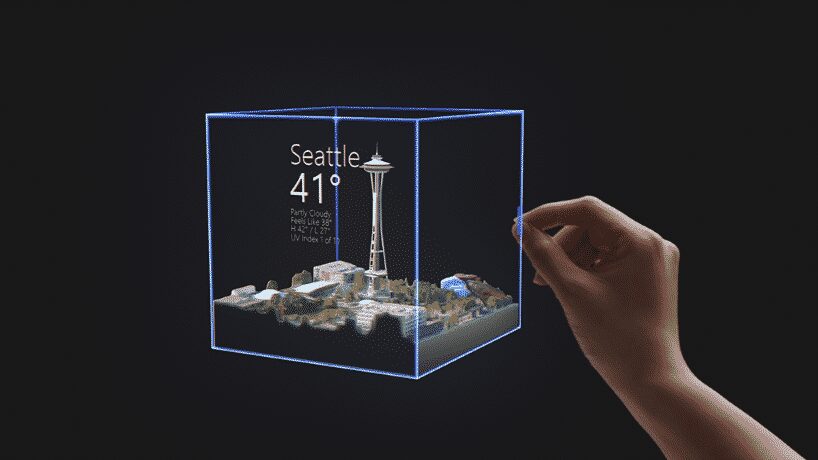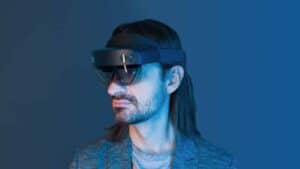After close to a year, Microsoft’s HoloLens 2 second-gen mixed reality headset is finally out. It was introduced back in February 2019 art Mobile World Congress, and the intervening delay has brought few surprises. There’s the innovative hand-gesture recognition that should go a long way toward minimizing frustrations for new users. It’s backed by real-time eye-tracking which gives you deeply immersive experiences of holograms in our increasingly cluttered virtual environments.
Microsoft’s Technical Fellow, Alex Kipman, refers to this as “Perception AI.” You interact with virtual objects the way we do with real-life objects. No latency, no controller, just your hands reaching out and grabbing something.
Perception is like reptile brain . . . It is performing those operations that your brain performs that are instinctual, that you don’t think about.

There is a new “dial-in” fit system, which should make the HMD easier to wear. Bear in mind that this is one of the few headsets where you are carrying everything on your head. There’s no hockey puck contraption like that for the Magic Leap One. And while we’ve always found the device fairly comfortable given its weight, the better balance and fit is helpful.
These are all good points counterbalanced by one major issue: cost. There’s just no getting around the $3,500 price. And at that level, most universities will pass on this solution for mixed reality. With that kind of money, you can buy eight Oculus Quests and still have money left over for accessories.
Research labs, healthcare organizations, and corporations will buy a few, but we doubt you’ll find large numbers of them in the field next year. Probably the most compelling market will be in healthcare education and engineering.
![]()
The most lucrative market in enterprise is employee training – and few sectors need a $3,500 device. What they need are a lot of inexpensive, easy-to-maintain HMDs like the Oculus Go or Quest. This is what attracts Walmart and others that purchase HMDs by the thousands.
Surprisingly, Microsoft seems to be ceding this ground to others.
Microsoft’s HoloLens 2 Specs
According to MS Power User, you get some serious state-of-the-art technology for $3,500:
Display:
- Optics – See-through holographic lenses (waveguides)
- Resolution – 2k 3:2 light engines
- Holographic Density – >2.5k radiants (light points per radian)
- Eye-based Rendering – Display optimization for 3D eye position
Sensors & Audio:
- Depth – Azure Kinect sensor
- IMU – Accelerometer, Gyroscope, Magnetometer
- Camera – 8MP stills, 1080p video
- Microphone Array – 5 channels
- Speakers – Built-in, Spatial Audio
Human Understanding:
- Hand Tracking – Two-handed fully articulated model, direct manipulation
- Eye Tracking – Real-time tracking
- Voice – Command and control on-device, Natural Language with internet connectivity
Environmental Understanding:
- 6DoF Tracking – World-scale positional tracking
- Spatial Mapping – Real-time environment mesh
- Mixed Reality Capture – Mixed hologram and physical environment photos and videos
Compute & Connectivity:
- SoC: Qualcomm Snapdragon 850 Compute Platform
- HPU: 2nd Generation Custom-built Holographic Processing Unit
- WiFi: 802.11ac 2×2
- Bluetooth: 5.0
- USB: USB Type-C
Power:
- Battery Life – 2-3 hours of active use
- Charging – USB Power Delivery – Fast Charging
- Thermals – Passively Cooled
Fit:
- Size – Fits over glasses, size using adjustment dial
Software:
- Windows Holographic OS
- Edge
- Remote Assist
- Layout
- Guides
- 3D Viewer
- OneDrive for Business
There remains a couple of challenges for Microsoft’s HoloLens 2. Battery life is still on the short side. There is little one can do about this while running high-res displays while wearing a battery on your head. And the field of view is lacking. HoloLens 2 improves on the narrow confines of gen-one (where did that hologram go?), but it’s still too small. According to the rumor mill in Redmond, you’ll have to wait for version 3 to have a full FoV.
The Future?
Does Microsoft’s HoloLens 2 have a future? The editor of Microsoft’s blog, John Roach, sums up the significant advance that the device represents:
The sensor-packed holographic computing headset uses AI to displace space and time, creating a mixed reality of people, places and things in order to facilitate one of our most basic human impulses: exchanging knowledge.
Microsoft Technical Fellow Alex Kipman said the headset defines the highest watermark of intelligent edge devices – AI-capable technologies that can collect and process data even without a reliable internet connection – and that can then share some or all of that data with the intelligent cloud when connected.
It’s a bold vision of the growing convergence of mixed reality and AI. The key element here is that it uses “AI to displace space and time.” And it can do so without a persistent connection to the cloud. That’s a remarkable achievement and essential in our world of limited 5G – which is more promise than reality.
But the real impact will come when the price drops or the technology ends up in other HMD’s. People are not going to walk around the world wearing HoloLens 2, or the follow-up. They will wear Apple’s AR Glasses when they arrive.
Microsoft’s HoloLens 2 also has some competition in the high-end mixed reality. Varjo’s mixed reality HMD may tie you to a computer, but it gives you an immersive experience that is close to our natural vision. The only advantage of HoloLens 2 is that it can be used out in the field.
Microsoft’s HoloLens 2 is a remarkable device that opens the door to the use of AI in spatial computing. But it’s the devices that follow that will reshape our experience of technology, the world, and ourselves.
Emory Craig is a writer, speaker, and consultant specializing in virtual reality (VR) and artificial intelligence (AI) with a rich background in art, new media, and higher education. A sought-after speaker at international conferences, he shares his unique insights on innovation and collaborates with universities, nonprofits, businesses, and international organizations to develop transformative initiatives in XR, AI, and digital ethics. Passionate about harnessing the potential of cutting-edge technologies, he explores the ethical ramifications of blending the real with the virtual, sparking meaningful conversations about the future of human experience in an increasingly interconnected world.

